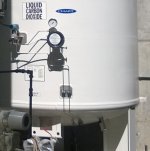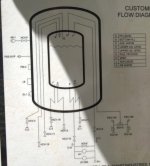TheWaterboy
Lifetime Supporting Member + Moderator
Tell me if I'm all wet here because I'm arguing with PE but I'm not yet convinced.
I have a 20 foot tall liquid CO2 Tank with vacuum jacket. The Level transmitter for this tank is mounted almost 3 feet from the bottom of the tank and its connections run down the side and into the bottom where I have to assume they connect to the top and bottom of the internal tank
I believe that I will be unable to accurately measure below the level of the mounted transmitter. i.e. nothing under 3 feet. The Engineer says that is not the case and it will work fine mounted there.
Since pressure in the tank will be equal, wont the column of liquid seek level at 3 feet ?
After writing that sentence it also occurs to me that there is no way that that cryogenic liquid is piped outside the tank against the diaphragm of that transmitter. There's no insulation on the lines. I wonder what does actually contact that transmitter...
I have added these to horizontal tanks and found this assumption to be true so what in this application am I'm missing here?
I have a 20 foot tall liquid CO2 Tank with vacuum jacket. The Level transmitter for this tank is mounted almost 3 feet from the bottom of the tank and its connections run down the side and into the bottom where I have to assume they connect to the top and bottom of the internal tank
I believe that I will be unable to accurately measure below the level of the mounted transmitter. i.e. nothing under 3 feet. The Engineer says that is not the case and it will work fine mounted there.
Since pressure in the tank will be equal, wont the column of liquid seek level at 3 feet ?
After writing that sentence it also occurs to me that there is no way that that cryogenic liquid is piped outside the tank against the diaphragm of that transmitter. There's no insulation on the lines. I wonder what does actually contact that transmitter...
I have added these to horizontal tanks and found this assumption to be true so what in this application am I'm missing here?





